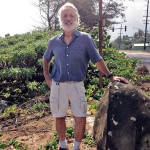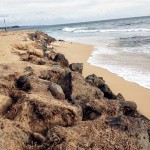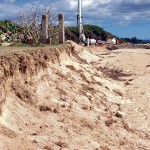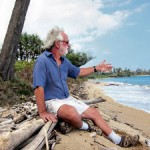Higher Ground
That’s where geologist Chuck Blay says folks should head as rising ocean levels and water temperature, along with unusual wind patterns, wreak havoc with beaches and shorelines – such as here at Wailua. Coco Zickos photo
There is no doubt in geologist Chuck Blay’s mind that sea levels are rising. “The question isn’t whether sea level is rising – it’s rising. The question is how we’re going to adapt to it,” says one of the island’s only earth scientists, while walking along what little remains of Wailua Beach.
Experts predict sea level will rise as much as 3 feet by the end of the century.
“However, we are now starting to realize that sea level is rising even faster than has been predicted,” he says.
And it appears to already be having an impact.
“We learn about shoreline problems related to wave erosion somewhere on the island all the time now,” says Blay, who is an independent researcher and educator.
Rather than wait for a crisis to occur, Blay believes it would be wise to begin making various changes – for example, shifting structures inland such as the Wailua Beach portion of the path to be constructed beginning early next year.
Because tradewinds have been notably stronger, waves engulfed much of the sand at the eastside beach, nearly reaching the highway during the summer months.
Although the beach is currently starting to come back, the shoreline position is still highly variable, according to a report by Ruby Pap, University of Hawai’i Sea Grant College Program’s Coastal Land Use Extension agent.
It is unknown whether the beach will ever regain its former width.
In an effort to curtail this issue, and should the need arise to move inland, the county’s chief of buildings, Doug Haigh, has come up with the idea to use 10-foot-long removable sections for that part of the path.
Efforts to mitigate the impact of disappearing shorelines also are under way in Kekaha, where the beach also drastically eroded this summer.
“It’s questionable right now as to whether that beach will come back,” says Blay, who was born in California and grew up in Washington and Oregon.
Changing weather patterns is one of the many reasons the sand may not return from where it currently rests along beaches at the Pacific Missile Range Facility. In addition, the rock revetment constructed along the beach in the 1980s may reflect the wave energy, further compromising natural efforts for the sand to rebuild.
Blay, who earned a degree in geology at Oregon State University and a Ph.D. at Indiana University, plans to conduct surveys in the area and study what long-term changes may be taking place and whether or not the sand will eventually return.
In the meantime, the Department of Transportation is currently working on an emergency project to protect the highway from the threat of erosion.
A wall with 40-foot-deep concrete shafts 3 feet in diameter that will extend approximately 400 feet from the existing revetment is slated to be completed by March 2013 at a cost of $6 million.
“Winter swells in October and November did return a significant amount of sand to the eroded area, but it is unknown if the erosion will continue,” says DOT’s Derek Inoshita. “This emergency project focuses specifically on minimizing potential damage to the highway and maintaining access to West Kaua’i.”
It is hard to pinpoint exactly what is causing these abrupt shoreline modifications.
“One thing that we do know for sure – and it’s no longer a debatable point – is that the planet is warming,” says Blay.
This rising heat affects wind, which is created by differential heating in the atmosphere by the sun, which, in turn, affects the waves (waves are another form of solar energy).
Trade winds have not only increased in strength during the past couple of decades, according to a published study by University of Hawai’i meteorologists, they have diminished in frequency.
This change also has an impact on rainfall, which has decreased in recent years. Average rainfall at Waialeale since its rain gauge was implemented in 1912 was 423 inches per year. However, in the past 17 years, the average has been some 350 inches.
Diminishing trade winds also bring hazier, vog-filled days to the island.
“Both moisture and Big Island vog will spread to Kaua’i and hang in the air without the glorious trade winds,” says Blay.
Blay’s enchantment with these and other geologic forces in Hawai’i began decades ago. Before moving to the island in 1995, Blay started visiting Hawai’i in the late 1970s. While traveling from Alaska, where he was doing field work, he would stay on Maui and the Big Island and eventually made his way to Kaua’i after hearing about Kalalau Trail.
“I remember saying out loud to myself when I got to about mile 9 with the view of Kalalau Valley, ‘I’m going to live here some day,'” he says.
He continued to visit Kaua’i on a regular basis, often camping at Polihale. As a sedimentology specialist, he recalls being enthralled with the sand at the westside beach.
It was the textbook on the geology of Hawai’i, Volcanoes in the Sea, however, that ultimately captivated his attention to the island.
In 1986, he returned to walk around almost the entire edge of Kaua’i.
“I wanted to know the shoreline,” says Blay, who formerly worked as a petroleum research geologist as well as an international consultant in the oil business in countries such as Indonesia and Ecuador. “I wanted to understand why there’s a beach here and not over there.”
He figured the best way to do so was to walk from one end to the other.
“You learn more about why a beach is where it is when you see where it’s not,” says Blay who is married to artist and
videographer, Jana Rothenberg.
What he found most interesting about the beaches around Kaua’i is that they are predominately light-colored, even though they surround a volcanic island.
“It’s something you might not expect,” says Blay, who also was a university professor for eight years and continues to serve as an affiliate professor at the University of Hawai’i, interacting with them on a research level.
The sand on the east side of the island, for example, consists of 40-60 percent coralline algae (plant), 20 percent coral fragments and less than 10 percent lava rock. Lava rock is not chemically stable, as it comes from high pressures and temperatures in the earth and breaks down when exposed to the low temperatures and pressures on the surface.
These geologic elements are among the many Blay has studied about Kaua’i since forming TEOK (The Edge of Kaua’i) Investigations nearly 20 years ago. He continues to participate in educational activities like weeklong seminars for science educators regarding the ecosystems of Kaua’i and geosciences on the Big Island. He also is creating a new edition of his book Kaua’i’s Geologic History, co-authored by his son Rob Siemers.
“I like Kaua’i better than any of the other islands because it’s more mature,” says Blay.
The island has had 5 million years to evolve and traveled some 350 miles (3.5 inches per year) from its original position where the Big Island currently resides.
While most of Hawai’i’s geologists prefer to study the active volcano, Blay finds the Garden Isle to be of more interest.
“And there are still a lot of things we don’t understand about Kaua’i,” says the Po’ipu resident. “The more I study Kaua’i, and the more I learn about it, the more questions I have.”
Blay also owns Kaua’i Nature Tours, which provides guided educational hikes where he discusses many geologic and cultural traits of the island.
The father of two adult children – fellow geologist Rob, and Troy, who is a math professor in Virginia – and grandfather of three boys, Blay also enjoys reading mostly nonfiction books and traveling, especially to Alaska, New Zealand and Australia.
Most of all, however, he enjoys being a self-proclaimed “lifelong learner.”
“I love discovery; I like those aha moments, those epiphanies,” he says.
Visit teok.com for more information. coco@midweekkauai.com
- That’s where geologist Chuck Blay says folks should head as rising ocean levels and water temperature, along with unusual wind patterns, wreak havoc with beaches and shorelines – such as here at Wailua. Coco Zickos photo
- Chuck Blay is a geologist and sedimentology specialist
- The beach has nearly disappeared in sections at what was Kekaha Beach
- The beach has nearly disappeared in sections at what was Kekaha Beach
- Chuck Blay explains what is happening at Wailua Beach and why waves intensified during the summer months








